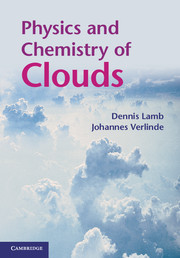Book contents
- Frontmatter
- Contents
- Preface
- Part I Background
- 1 Introduction
- 2 The atmospheric setting
- Part II Transformations
- Part III Cloud macrophysics
- Part IV Cloud microphysics
- Part V Cloud-scale and population effects
- Appendix A Cloud classification
- Appendix B Overview of thermodynamics
- Appendix C Boltzmann distribution
- References
- Index
2 - The atmospheric setting
from Part I - Background
Published online by Cambridge University Press: 07 October 2011
- Frontmatter
- Contents
- Preface
- Part I Background
- 1 Introduction
- 2 The atmospheric setting
- Part II Transformations
- Part III Cloud macrophysics
- Part IV Cloud microphysics
- Part V Cloud-scale and population effects
- Appendix A Cloud classification
- Appendix B Overview of thermodynamics
- Appendix C Boltzmann distribution
- References
- Index
Summary
Clouds form in an atmosphere that is rich in water vapor and diverse chemical compounds. These components reside in the Earth's gaseous envelope and so become organized is ways that respond to gravitational attraction and to the steady input of energy from the Sun. If we are to understand the properties and behavior of atmospheric clouds, we must first understand the environment in which clouds form.
Composition
What actually makes up or constitutes the Earth's atmosphere? The answer to such a question depends on time, for the composition of the atmosphere has been and still is changing. For some compounds the changes are slow, for others they are rapid. Here, we explore how the atmosphere evolved to its present form, the fundamental nature of the substances making up the atmosphere, and how those substances are currently distributed throughout the atmosphere.
History of the atmosphere
Our atmosphere has evolved dramatically since the Earth formed some 4.6 billion (4.6 × 109) years ago. Initially, while the Earth was still hot from the gravitational accumulation of matter in the solar nebula and from the heavy bombardment of rocky planetesimals, the atmospheric composition was more akin to that of the Sun. It is during this early heavy-bombardment period that the Moon most likely formed and helped stabilize the Earth's rotational axis. The primary or proto-atmosphere contained much hydrogen and helium, reflecting the dominant composition of the stellar matter.
- Type
- Chapter
- Information
- Physics and Chemistry of Clouds , pp. 29 - 122Publisher: Cambridge University PressPrint publication year: 2011



